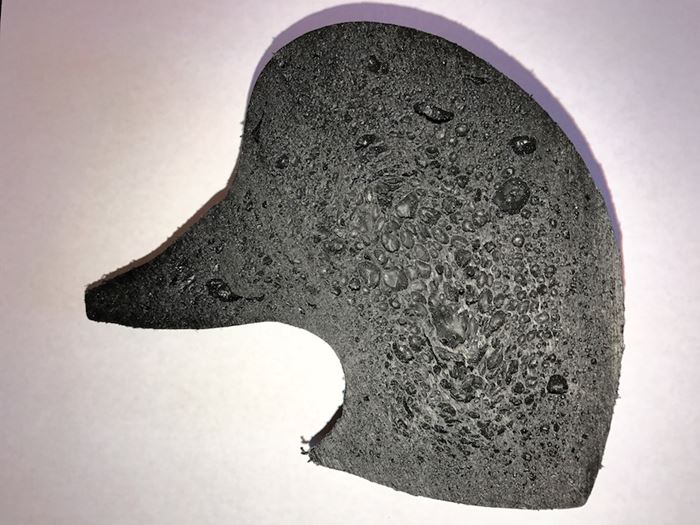New Process & Material Permits Big Weight Savings on Foamed Parts
New firm develops technology that offers weight reductions up to 65% for large injection molded polyolefin parts.
A maker of duck decoys has applied for a patent on a plastic cellular structure technology that allows dramatic density reductions in large injection molded polyolefin parts, using a standard press and without affecting the part’s surface or structural integrity. In addition to cutting weight by 65%, the inventors say the foam structure, for which they can control bubble size and arrangement, imparts greater strength to the finished components.
For hunters of water fowl, apart from a gun, a dog, and warm clothes, one must-have element to a successful trip are decoys. Typical decoys are hollow blow molded parts, designed to float, but if struck by shotgun pellets—a distinct possibility given their role in luring ducks within firing range—they tend to sink.
To overcome this, some decoy makers have turned to foamed PS cores, which must be wrapped in burlap and other materials in a labor- and time-intensive process that precludes them from mass production and still presents durability issues. That’s why Jason Minnich and Travis Biggs, owners of Lake Effect Decoy Co. LLC in Cochranton, Pa., saw a market opportunity if they could mass produce a rugged decoy that wouldn’t be hamstrung by the volume and variability issues associated with hand-made solid decoys.
The technology they came up with, for which they filed for patents in February, has led to the creation of a new company, Moxietec, which will license the process and materials for the technology, tradenamed NautXcell, to other companies and markets.
“NautXcell requires a very unique blend of materials and process to achieve the solid core. We’re looking to partner with some bigger companies that can utilize this technology,” Biggs says. “That’s our main goal: grow the Moxietec business with the technology of NautXcell and find other companies that can utilize it.”
Five-Plus Years of R&D
Biggs says Lake Effect began development of a “solid” alternative five or six years ago, initially focusing on the duck’s head. Once that was perfected, the company moved onto the larger decoy body, spending nearly two years tweaking the compound, process, and mold for that larger component.
“There were major hurdles to overcome,” Biggs says. “We wanted to create a solid, lightweight part, utilizing a standard injection molding machine. The biggest challenge was being able to create the honeycomb-like solid core.” Early testing produced parts that were severely deformed and exhibited a loss of surface detail, according to Biggs.
The heads and bodies are molded on two separate machines. The heads have a volume of 49.6 in.3 and a weight of 9 oz, while the bodies have a volume of 291.15 in.3 and a weight of 59.2 oz. If the head and body were molded as solid parts without NautXcell, Biggs says the respective part weights would be 27.12 and 154 oz. The inventors see great potential utility in other thick parts, given that the decoy’s body measures 9.25 in. wide at its thickest point, with a length of 16 in.
In terms of materials, the company has had success with high- and low-density polyethylene, as well as polypropylene. The technology utilizes a pre-compounded pellet loaded with a blowing agent and what was described as several other chemicals. The company declined to say whether the blowing agent was of the physical or chemical variety.
Biggs noted that there are some “pretty unique” elements to the process itself, in terms of temperatures, injection phase, and cooling, but added that all the work was done on a standard press, with no changes to its primary components. Elements of the tools’ venting and heating/cooling had to be specially developed as well.
Today using NautXcell, Biggs says a molder can control the size of the cell structure and its density, making the internal cells very large so a part becomes buoyant, for instance, or creating a denser cell structure to boost component’s strength. Furthermore, molders can modify the material and process to alter the density of the solid outer skin to achieve a variety of wear, impact, and anti-ballistic characteristics. In durability testing, the company has shot at and run over its Gale Force Series decoys, supporting its claim to offer “the most durable production decoy on the market.”
Related Content
New Entrant Heartland Polymers Stepping up as Reliable Supplier
Heartland Polymers’ new Alberta, Canada facility will produce 525 KTA propylene and 525 KTA polypropylene. It is expected to stabilize supply chains across the continent.
Read MoreFirst Quarter Looks Mostly Flat for Resin Prices
Temporary upward blips don't indicate any sustained movement in the near term.
Read MoreFundamentals of Polyethylene – Part 6: PE Performance
Don’t assume you know everything there is to know about PE because it’s been around so long. Here is yet another example of how the performance of PE is influenced by molecular weight and density.
Read MoreIn Sustainable Packaging, the Word is ‘Monomaterial’
In both flexible and rigid packaging, the trend is to replace multimaterial laminates, coextrusions and “composites” with single-material structures, usually based on PE or PP. Nonpackaging applications are following suit.
Read MoreRead Next
People 4.0 – How to Get Buy-In from Your Staff for Industry 4.0 Systems
Implementing a production monitoring system as the foundation of a ‘smart factory’ is about integrating people with new technology as much as it is about integrating machines and computers. Here are tips from a company that has gone through the process.
Read MoreProcessor Turns to AI to Help Keep Machines Humming
At captive processor McConkey, a new generation of artificial intelligence models, highlighted by ChatGPT, is helping it wade through the shortage of skilled labor and keep its production lines churning out good parts.
Read MoreAdvanced Recycling: Beyond Pyrolysis
Consumer-product brand owners increasingly see advanced chemical recycling as a necessary complement to mechanical recycling if they are to meet ambitious goals for a circular economy in the next decade. Dozens of technology providers are developing new technologies to overcome the limitations of existing pyrolysis methods and to commercialize various alternative approaches to chemical recycling of plastics.
Read More













.png;maxWidth=300;quality=90)














